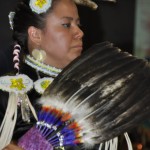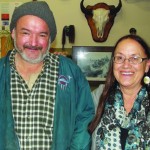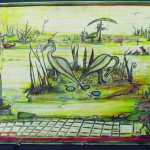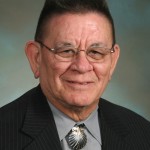Month: December 2012
Department of Justice announces Eagle Feathers Policy
 Possession or Use of the Feathers or Other Parts of Federally Protected Birds for Tribal Cultural and Religious Purposes
Possession or Use of the Feathers or Other Parts of Federally Protected Birds for Tribal Cultural and Religious Purposes
By Monica Brown, Tulalip Tribes Communications Department; Photo by Brandi Montreuil
On October 12, 2012, the Department of Justice announced a policy addressing the ability of members of federally recognized Indian tribes to possess or use eagle feathers, an issue of great cultural significance to many tribes and their members. Attorney General Eric Holder signed the new policy after extensive Department consultation with tribal leaders and tribal groups. The policy covers all federally protected birds, bird feathers and bird parts.
The policy provides generally that the Department of Justice will not prosecute members of federally recognized tribes who:
- Have or use the feathers or other parts of eagles or other migratory birds.
- Pick up naturally fallen or molted feathers found in the wild, without disturbing birds or their nests.
- Give or lend the feathers or other parts of eagles or other migratory birds to other members of federally recognized tribes.
- Exchange with other members of federally recognized tribes, without payment of any kind, the feathers or other parts of eagles or other migratory birds for other such items.
- Give the feathers or other parts of eagles or other migratory birds to craftspersons who are also members of federally recognized tribes to be fashioned into cultural or religious items. Craftspersons may be paid for their work, but no payment may be made for the feathers or other parts of the eagles or other migratory birds.
- Travel in the United States with the feathers or other parts of eagles or other migratory birds.
- Travel internationally with the feathers or other parts of eagles or other migratory birds, subject to permit requirements.
The Department of Justice will continue to prosecute tribal members and nonmembers alike for:
- Buying or selling the feathers or other parts of eagles or other migratory birds or trading them for goods or services (or attempting to do so).
- Killing federally protected birds without a permit. Tribal members can apply to the U.S. Fish and Wildlife Service for permits to take (including kill) eagles for religious purposes.
- Members of federally recognized tribes do not need permits to possess the feathers or other parts of eagles or other migratory birds or to engage in the other activities listed above (with the exception of certain international travel).
The Department Policy for Federally Recognized Tribal members PDF can be viewed here.
Tulalip homeless shelter needs our support

Article and photo by Jeannie Briones
TULALIP, Washington- “Many people come to the shelter with almost nothing. They have no food, no money and inadequate or ill fitting clothing for themselves and their children. The children may have no school supplies. When the weather gets really cold, the children often don’t have hats, gloves or a warm coat. When the residents move out they usually need everything; dishes, silverware, pots and pans, towels, and bedding and may have little or no furniture. The shelter has no storage space, but we often know of people who need donated furniture,” said Homeless Shelter Coordinator, Sandy Tracy.
Tulalip homeless shelter donations have drastically dropped from the past year. Food, clothing, and household items are greatly needed.
Tulalip and other tribal families are provided with temporary shelter at the Tulalip shelter. Some food is provided, based on what they receive from community donations, and depending on their income, some shelter residents may qualify for food vouchers through Tulalip Temporary Assistance for Needy Families.
The homeless shelter relies on community donations to provide residents with their basic needs. The shelter is currently in need of bedding, silverware, dishes, pots and pans, laundry detergent, kids toys, flashlights, school supplies, any food donations, and warm clothing for adults and children.
One of the shelter residents, Gerald Charles, received warm clothing donations from the Tulalip Church of God. The church also provided the shelter with bedding and a food gift card so residents will be able to enjoy a Christmas meal at the shelter.
If you are interested in making a donation, please contact Homeless Shelter Coordinator, Sandy Tracy, at 360-716-4705 or stracy@tulaliptribes-nsn.gov. Tulalip Homeless Shelter is located at2817 Mission Hill Road,Tulalip,WA98271.
Jeannie Briones: 360-716-4188; jbriones@tulalipbribes-nsn.gov
Tahoma Indian Center, restoring and sustaining the dignity of urban Indians

By Kyle Taylor Lucas, Tulalip tribal member, guest reporter
Joan Staples-Baum, Director, Tahoma Indian Center
She is nearly seventy, but you wound not guess she is a day over fifty. There’s a twinkle in her eye, but immediately striking is a sense of inner strength, wisdom, and dignity. Her eyes say that she has seen much. No doubt, great inner strength was pivotal to her daily work with Native America’s rejected and forgotten, many of whom live under bridges and on the streets of Tacoma. She is Joan Staples-Baum, White Earth Chippewa from Minnesota, and she has been the program manager at the Tahoma Indian Center for nearly 22 years.
At the end of this year, Staples-Baum will leave the center that she and two other American Indian women, Betty Sampson, Swinomish and Jeanette DeCoteau, Turtle Mountain Chippewa, founded in October 1991. Sampson, who worked daily at the center, sadly since deceased. DeCoteau is a Physician’s Assistant at Muckleshoot Tribe.
“To me the key to survival as an Indian is to know who you are,” said Staples-Baum. Over the past 22 years, she has dedicated her life to ensuring that urban Indians in Tacoma get that chance.
In January, Staples-Baum will journey across country to join the love of her life, Gilbert Moran, Turtle Mountain Chippewa, in Belcourt North Dakota where, among pursuing interests long put on hold, she will help him write a book documenting his language as one of its last speakers.
An artist, she’ll pursue arts and crafts, further research family ancestry, and infuse her life with more spiritual direction as well.
Joan Staples-Baum was born in 1942, the middle child of ten. Her parents moved off the reservation to provide educational opportunities for their children. She noted that it is hard for those who have left the reservation, often through no fault of their own. When they attempt to return home, they are not accepted.
Also of Finnish descent, in 1988 she traveled with her mother to Finland where she met her mother’s first cousins. “Finland is so Indian it’s unbelievable! Oh my God, I got a double whammy being Finnish and Indian.” She described a community set up like longhouses where adults lived in the big house, kids in small houses, with a full range of community services in the middle.
Staples-Baum completed her undergraduate work at Seattle Pacific University and earned her MSW at Seattle University in 1997. She is the mother of two and the proud grandmother of two grandchildren, ages 8 and 12.

Tahoma Indian Center
According to its mission, the Tahoma Indian Center was “established to help restore and sustain the dignity of Urban Native American Indians. We believe in living out a ministry of presence by offering a safe place where hopes can be revived, hearts healed, and lives can begin anew. We are a drop-in resource center designed to nurture and build up Native Peoples through service and advocacy.”
It is a long narrow building with a bright blue front at 1556 Market Street in Tacoma and is open Monday through Friday from 9:00 a.m. to 3:00 p.m. Those utilizing the center and its services consider it a blessing. Upon entrance, one feels immediately welcomed. Tables with chairs line both sides of the long room, a long series of comfortable benches line the center of the room. A computer center is available where Indians can access their email, search and apply for jobs, or seek information. There is access to a phone, a physical address for mail, and laundry services. The coffee is always ready and a full meal is served once daily.
The center provides referrals to needed social services such as housing, food, clothing, employment and training, legal services, education, as well as referrals to culturally specific services such as tribal registration, pow-wows, counseling, recovery, and healing
The center operates under the umbrella of Catholic Community Services and receives the bulk of its funding from grants and the support of funders such as the Tulalip Tribes, Muckleshoot Tribe, Puyallup Tribe, Snoqualmie Tribe, and the United Way of Pierce County. Last year, the center served 1,133 urban Indians.
Staples-Baum emphasized, “We’ve intentionally not sought local government funding because we would have to open the doors to everyone and we feel it’s important to maintain the center for Natives. I’ve seen what happens when you accept that funding, the Natives get lost in the mix.” Essentially, the Native people and their unique needs are over-shadowed.
Prior to founding the Indian center, Staples-Baum worked at another local support center and noticed that the Indians came in, quietly got their plates, and went to the back. Shortly thereafter, she, Sampson, and DeCoteau, hatched the idea to create a center that would focus on the unique cultural and identity needs of urban Native peoples.
Pointing to a beautiful portrait of Kenny Moses, a traditional healer of the Tulalip Tribes, she happily recalled his special blessing of the center at its original location on Yakima Street in 1991.
The center has a board of 12 members, all Native except for one representative of the Catholic Community Service. Some are center users. Tahoma Indian Center Board Chair, Peter Hayes (Choctaw), and his wife and family bring the Native community together every year to prepare and serve Thanksgiving dinner.
On a more sober note, more than a third of those served by the center are homeless Indians. They sleep at homeless shelters, under bridges, or in their cars. The average age is 30 to 45, some veterans, a few over 50. About a third of those served are women whose needs are unique because they are especially vulnerable living on the streets.
“We welcome all Indians to the center and we don’t judge. We try to help them find their way. According to the 2010 census, the majority of Natives live in the city today, and most of them for reasons not of their own doing. We’re scattered around. We don’t have a housing section. The center helps us find each other,” said Staples-Baum.
The center has been a cultural center, too, a place for Indians to practice beading, to weave, to drum, to dance. They have held classes in drum making and in beadwork and weaving, and have encouraged center clients to avail themselves of Native art classes through The Evergreen State College longhouse and with Native teachers in classes at the center.
When asked whether she has been involved in political advocacy for urban Indians, Staples-Baum said, “I have no right to intervene with any of the tribes, politically. My role is to ensure a neutral line. We have been grateful for the support of the tribes.” She once worked with a few others in securing passage of a resolution by Affiliated Tribes of Northwest Indians to support urban Indians, but said that nothing more came of it.
Memorial Wall
A grim reminder of the tragic lives of a majority of those served by the center is the center’s memorial wall. Most of those remembered passed from suicide, murder, drugs, alcohol, or cancer. Tragically, “There’s probably not one natural death on it,” said Staples-Baum who pointed to photos, “See that young woman in the hat, she’s Tulalip, and she was strangled to death; that young man was murdered; she died of AIDs, he was killed by police; he committed suicide; he died of drugs.”
Despite the legacy of desperate lives, likely otherwise forgotten, on the memorial wall, the center has and continues to fulfill the wide-spectrum of the human experience, including celebrations of life. “We’ve had naming ceremonies, baptisms, weddings, Shaker Church services, memorial services, and funerals.”

Tyrone Patkoski – Tulalip “Outside Artist”
Against the stark realities and lives of those served by the center, when asked what has kept her going all these years, Staples-Baum said, “It’s people like Tyrone Patkoski.”
Tyrone Patkoski, an enrolled Tulalip tribal member, has lived on the margins of society for most of his life and on the streets for more than three decades. His last job was in 1976 when he cleaned movie theaters. Since then, he has survived by selling metals, which he said, “kept gas in the car and the insurance paid.” Staples-Baum said, “Tyrone was one of the first environmentalists, believing in re-use.” Tyrone often incorporates found objects into his art.
Patkoski said he first became homeless in the early seventies, “Starting about 1971, I was wandering around, staying in my panel truck. Some people let me park at their house. Wasn’t no fun driving around trying to find a place to stay. After that, I sometimes lived under the bridge, or slept in my car when I had one.” He was especially happy about the years that the Puyallup Tribe allowed him to stay at the river.
Despite a difficult adulthood marked by homelessness, periods of mental illness and depression, Tyrone shared fond memories of his youth and times spent with extended family in cascara bark gathering, berry picking, and trout fishing. He happily recalled how he “wandered around the mountains with family and we’d get together for picnics.” He shared black and white photos of his lovely young mother and father, saying that his father was in the army and the navy. His tone was disapproving as he recalled that his dad used to shoot bottles off the top of his mother’s head. He was clearly proud of his uncle Kenny Moses and marveled that his uncle Amos Moses was hit twice by lightening.
Staples-Baum said that she met Tyrone when his sister brought him into the center 20 years ago. He worried about losing his art to street thugs, so she offered to store it at the center. While she had marveled at his artwork, Patkoski’s big break came when she introduced him to former News Tribune photographer Casey Madison. Madison admired his work and encouraged Staples-Baum to frame it, so she secured $2,000 in funding from an anonymous donor. Tacoma Art Supply framer Glenn Leonard loved Tyrone’s work and helped organize the first exhibition and public recognition of his art in May 2010. Tyrone and his show were also featured on King5 television. Total sales amounted to a few thousand dollars, which has helped to support him and to buy canvasses, brushes, and paint. Tyrone Patkoski’s work can been seen at www.TyronePatkoski.com.
In a “Weekly Volcano” review of Tyrone’s art, Alec Clayton said, “An unheralded and untrained artist with innate talent, guts and sincerity is discovered. There is nothing in these densely packed images that does not refer to something in his life experience, his demons, or his hopes.”
Asked what inspires him, Tyrone mumbled, “I don’t think about what I’ll paint. I just let the paint decide.” Asked when he creates, he said, “I like to work at night when I have materials, but I need linseed oil, canvasses, and brushes – which are expensive.”
At the mention of his sister, Helen, Tyrone was cheered, but suddenly blurted, “Helen died from alcohol, she had a rough life. Her boyfriend got her drinking Thunderbird and eventually she had an aneurism and lost half her memory. Then she died.” He choked, “Rainy days are hard. When it gets rainy, I always think about Helen,” a tear rolled down his cheek. Wiping it away with his sleeve, he was unable to talk. One is struck by his vulnerability. He seemed appreciative of a stranger’s condolence and consolation, though it was clear that such human touch was unfamiliar. Even upon meeting and extending a handshake, he reacted in surprise as though such a gesture is rare.
Tyrone is a big guy, at least 6’ tall with broad shoulders. Staples-Baum calls him a “gentle giant,” and later remarked, “I’m happy and surprised that he opened up and talked with you, he rarely speaks to anyone, so this was unusual and special.” Perhaps it helped to be interviewed by another Tulalip who happens to be a freelance journalist, but also by someone who treated him as an equal.
Since about the age of 20, he says his medium has mostly been “oil paints on canvass and acrylics on the bugs with some ink pens on paper,” but many of his early works were ink drawings on the backs of file folders and boxes.
After the center closed, we three stayed late for the interview. In the sudden quiet, Staples-Baum brought out of storage a huge 4-foot folio of Tyrone’s work. She began to lay the very unique and colorful pieces out, all the while gently asking Tyrone about them. Before long, he was quietly chuckling and offering brief, shy, comments about the various aspects, influences–Van Gogh and Picasso, and meanings of his truly remarkable drawings and paintings.
Shy and humble, he seems almost childlike, yet his art often conveys deep thought, sometimes dark and disturbing reflections on drugs, needles, 8-balls, alcohol, gambling, and the painful and destructive human experiences he has witnessed first-hand on the streets; then, alternately humorous commentary of current affairs and the mundane.
Tyrone is an environmentalist who paints ducks stuck in an oil spill, a moralist who draws monkeys being shot into space in rockets, and a humanist who decries Satan stealing humans with needles and 8-balls depicted in many of his drawings and paintings. Then, there are his acrylic 3-dimensional bug pieces that depict the human existence from the sublime to the ridiculous.
The fortunate viewer is instantly struck by the abstract and intricate designs with layered meanings infused in each Patkoski art piece, whether his drawings, oil paintings, watercolors, or 3-dimensional acrylic pieces. Yet, Tyrone has quickly moved on to the 4-foot portfolio where he delights in re-discovering and sharing his past works, some dating to the early seventies. If Tyrone is quietly pointing out the next piece, one dare not be detained by the last mesmerizing piece.
After living on the street, under bridges, and in his car or panel van for nearly thirty years, Tyrone Patkoski finally has a home of his own. A kindly man who became his friend had allowed him to stay on his property. “I spent about ten years sitting in the car outside Butch’s house with ink pens and paper. He brought me there to be his security guard.” When he passed away, he left his house to Tyrone. Staples-Baum contacted Tulalip Tribes when he was, shortly thereafter, about to lose the home due to back-taxes. She said, “Tulalip Tribes stepped in to help Tyrone and keep his home from foreclosure.”
Asked what he liked best about having a home, Tyrone’s stark and simple reply is, “It’s really nice when it’s cold and rainy.”
Hopes for the Center’s Future
As Tahoma Indian Center founder, Joan Staples-Baum leaves, she shared her thoughts on her legacy and hopes for the center’s future. Her parting thoughts are characteristically in keeping with the pragmatic and humble approach she has taken to managing the center for 22 years. “I hope there will not only be a safe place for urban Indians to hang out during the day, to get something to eat, and to have a sense of community, but I hope the center will provide a space where people feel safe to be who they are, feel respected, and to be inspired to make changes themselves.”
Grab a camera and head to the beach “King Tides” are here
 By Monica Brown, Tulalip Tribes Communications Department Photo By Brandi Montreuil
By Monica Brown, Tulalip Tribes Communications Department Photo By Brandi Montreuil
Washington’s department of Ecology is inviting residents and visitors to help track the high tides that occur in the December and January months. During these months the moon and sun align and cause an increase in the gravitational pull on our Earth’s oceans. Residents can upload and view photos from shores along Washington coastlines. Flickr account is located here; Washington King Tides Photos Initiative’s Flickr Group.
The purpose of this initiative is to track the rising sea levels and the impact they have on the environment. The Ecology department has tide schedules and maps available on their site, Department of Ecology. Other areas taking part in this project are British Columbia, Oregon and parts of California: San Francisco Bay Area, Santa Monica and San Diego .
McCoy heads up the new Community Development, Housing & Tribal Affairs Committee
OLYMPIA – A veteran Snohomish County lawmaker is poised to take the reins of a key, reconfigured legislative panel.
State Rep. John McCoy will chair the new Community Development, Housing & Tribal Affairs Committee in the Washington State House of Representatives. With his appointment just recently confirmed by the members of the House Democratic Caucus, McCoy will assume responsibilities for putting the committee gavel to work when the 2013 legislative session launches Monday morning, Jan. 14.
In addition to the critical matters defined in its title, McCoy’s committee has dominion over issues involving veterans, tourism, and parks/recreation affairs.
“We will review topics ranging from accessibility and affordability of housing, to state-assistance for low-income housing, to rules and regulations for housing authorities, to the Housing Finance Commission, itself,” McCoy said.
“I am very excited to help move our state forward on the exploration of these concerns and related issues,” added the recently re-elected legislator, who will be leaving his post as chair of the House Technology, Energy & Communications Committee. Indeed, in the past several years he has played a substantial role in shaping policy discussions around technology, energy and communications problems and questions.
But hold on, folks. The work for McCoy, D-Tulalip, in the upcoming session doesn’t end with the Community Development, Housing & Tribal Affairs Committee. He’s also taking on the responsibilities of vice-chairing the House Environment Committee.
The Environment Committee looks at topics involving air quality, aquatic lands, oil-spill prevention, recycling and solid waste, hazardous waste, toxics, climate change, renewable-energy standards, as well as energy availability, production and conservation. Further, this committee maintains a close eye on what the Puget Sound Partnership is up to regarding Puget Sound and Hood Canal.
Yes, there’s more. McCoy will keep his position on the House Education Committee. And no, good people, you don’t need to be any sort of modern-day Horace Mann to know what subjects that committee deals with.
UIHI Launches Native Generations Campaign to protect Native babies
Press Release, Crystal Tetrick, UIHI
SEATTLE, 2012 – For every 1,000 American Indian and Alaska Native babies born in U.S. cities, as many as 15 die before their first birthday*. To raise awareness and share valuable health and prevention messages about this problem, the Urban Indian Health Institute (UIHI) has launched Native Generations, a campaign addressing the high rates of infant mortality among American Indians and Alaska Natives. The campaign was made possible by funding from the U.S. Department of Health and Human Services’ Office of Minority Health.
“We are pleased to launch the Native Generations campaign, which highlights examples of innovative and vital programs serving Native families in two major cities,” said Ralph Forquera, Founding Director of the Urban Indian Health Institute, a division of the Seattle Indian Health Board. “The majority of American Indians and Alaska Natives – almost 70 percent – reside in urban areas. As the Native Generations video shows, connecting families to health care and providing support grounded in Native culture can reduce risk for infant death and help put an end to the infant mortality crisis.”
Native Generations depicts examples of effective approaches to outreach in Seattle and Detroit. As a vital prevention strategy, the video shares compelling stories of urban Native parents who have discovered ways to embrace their culture and community for the health of their families. The video teaches parents about infant health, safety practices and health risks.
“The disparities in infant mortality and maternal and child health among American Indians and Alaska Natives are striking,” said J. Nadine Gracia, M.D., M.S.C.E., Acting Director of the Office of Minority Health. “Efforts like Native Generations underscore that, when culturally competent services are combined with awareness and education, we can make a difference in improving infant health and reducing disparities.”
In the next few months, the Urban Indian Health Institute plans to distribute the video to health providers and community organizations that serve American Indian and Alaska Native families.
There are Urban Indian Health Organizations in 20 states supporting Native generations in urban areas. Urban Indian Health Organizations provide health services, cultural activities and resources to protect the health and well-being of Native generations.The Office of Minority Health is dedicated to improving the health status of racial and ethnic minority populations – including African Americans, Hispanic Americans, American Indians and Alaska Natives, Asian Americans, Native Hawaiians, and Pacific Islanders – through the development of policies and programs that will eliminate health disparities.
View the video along with materials and other resources for families on the Native Generations webpage: www.uihi.org/NativeGenerations.
*Data Source: Linked Birth-Death Certificate Data: U.S. National Center for Health Statistics, UIHO service area counties, 2002-06
Memorandum of Understanding (MOU) to improve the protection of Indian sacred sites
By Monica Brown, Tulalip Tribes Communications Department
News Release
Release No. 0354.12
Contact:
USDA Office of Communications (202) 720-4623
Departments of Agriculture, Defense, Energy, and Interior Sign Memorandum to Collaborate to Protect Indian Sacred Sites
Advisory Council on Historic Preservation Also Participates
WASHINGTON, Dec. 6, 2012—Four cabinet-level departments joined the Advisory Council on Historic Preservation today in signing a Memorandum of Understanding (MOU) to improve the protection of Indian sacred sites. The MOU also calls for improving tribal access to the sites. It was signed by cabinet secretaries from the U.S. Departments of Agriculture, Defense, Energy and Interior. It was also signed by the chairman of the Advisory Council on Historic Preservation.
“The President is insistent that these Sacred Sites be protected and preserved: treated with dignity and respect. That is also my commitment as Secretary of USDA,” said Agriculture Secretary Tom Vilsack. “I know my fellow Secretaries share in this commitment. We understand the importance of these sites and will do our best to make sure they are protected and respected.”
“American Indian service members are fighting to protect America on distant battlefields,” said Defense Secretary Leon Panetta. “I’m pleased this new agreement will help protect Indian sacred sites here at home.”
“Protecting America’s air and water and our nation’s heritage is an important part of the Energy Department’s commitment to Tribal Nations across the country, particularly those that are neighbors to the Department’s National Laboratories, sites and facilities,” said Energy Secretary Steven Chu. “I look forward to continuing this important work and collaborating with other federal agencies and Tribal Nations to protect Indian sacred sites throughout the United States.”
“We have a special, shared responsibility to respect and foster American Indian and Alaska Native cultural and religious heritage, and today’s agreement recognizes that important role,” said Secretary of the Interior Ken Salazar. “Inter-agency cooperation fosters our nation-to-nation relationship with tribes, and that’s certainly true when it comes to identifying and avoiding impacts to the sites that tribes hold sacred.”
“Through collaboration and consultation, the signatory agencies will work to raise awareness about Indian sacred sites and the importance of maintaining their integrity. The tools to be developed under this MOU will help agencies meet their Section 106 responsibilities,” said Milford Wayne Donaldson, FAIA, ACHP chairman. “The Advisory Council on Historic Preservation is very pleased to be part of this historic initiative to address the protection and preservation of Indian sacred sites.”
The MOU will be in effect for five years and requires participating agencies to determine inter-agency measures to protect sacred sites. It also sets up a framework for consultation with tribes, creation of a training program for federal employees to provide educational opportunities concerning legal protections and limitations related to protection of the sites, creation of a website that includes links to federal agency responsibilities regarding sacred sites and the establishment of management practices that could include collaborative stewardship of those sites.
The MOU calls for development of guidance for management and treatment of sacred sites including creation of sample tribal-agency agreements. It sets up a public outreach plan to maintain, protect and preserve the sites, and calls for identification of impediments to federal-level protection of the sites. Additionally, the MOU provides for outreach to non-federal partners, tribal capacity-building efforts and it establishes a working group to implement the terms of the agreement.
Source: http://usda.gov/wps/portal/usda/usdahome?contentid=2012/12/0354.xml&contentidonly=true
#
USDA is an equal opportunity provider and employer. To file a complaint of discrimination, write to USDA, Assistant Secretary for Civil Rights, Office of the Assistant Secretary for Civil Rights, 1400 Independence Avenue, S.W., Stop 9410, Washington, DC 20250-9410, or call toll-free at (866) 632-9992 (English) or (800) 877-8339 (TDD) or (866) 377-8642 (English Federal-relay) or (800) 845-6136 (Spanish Federal-relay).
US Department of Labor to publish final tribal consultation policy
Press Release, U.S. Department of Labor, Office of Public Affairs
WASHINGTON — The U.S. Department of Labor will publish in the Federal Register next week its finalized tribal consultation policy, which establishes a formal process through which the department will engage in consultation with federally recognized tribes on actions or policies that will have a significant impact on tribal nations. This policy requires that the department’s government-to-government consultation with the federally recognized tribes involve appropriate tribal and department officials.
“The finalization of the Department of Labor’s tribal consultation policy constitutes an important step in our ongoing efforts to more meaningfully engage with Indian Country,” said Secretary of Labor Hilda L. Solis. “Implementation of this policy will ensure that the department honors the government-to-government relationship shared between the United States and the federally recognized tribes.”
President Obama previously has cited Executive Order 13175, which was issued by President Clinton, tasking executive branch departments and agencies with engaging in regular and meaningful consultation and collaboration with tribal officials in the development of federal policies that have tribal implications.
Following the president’s charge, the Department of Labor began devising a plan. The Department of Labor held a series of consultative listening sessions, including meetings with representatives of the Native American community, the department’s Native American Employment and Training Council and the National Congress of American Indians, preceding the finalization of the tribal consultation policy. A draft version of the policy was published in the Federal Register on April 18, 2012, followed by a comment period that ended June 18.
The final policy will be published during the week of Dec. 3. A copy can be viewed at http://www.dol.gov/ope/tribal-consultation-policy.htm
VA and Indian Health Service announce national reimbursement agreement
Native Veterans Able to Access Care Closer to Home
Press Release, Department of Veterans Affairs, www.va.gov
WASHINGTON — American Indian and Alaska Native Veterans will soon have increased access to health care services closer to home following a recent Department of Veterans Affairs and Indian Health Service (IHS) joint national agreement.
“There is a long, distinguished tradition of military service among tribes,” said Secretary of Veterans Affairs Eric K. Shinseki. “VA is committed to expanding access to native Veterans with the full range of VA programs, as earned by their service to our Nation.”
“The President has called on all Cabinet Secretaries to find better ways to provide our military families with the support they deserve, and that is exactly what we are doing today,” said Kathleen Sebelius, Secretary of the U.S. Department of Health and Human Services. “American Indian and Alaska Native Veterans benefit from this agreement, which provides increased options for health care services.”
As a result of the national agreement, VA is now able to reimburse the IHS for direct care services provided to eligible American Indian and Alaska Native Veterans. While the national agreement applies only to VA and IHS, it will inform agreements negotiated between the VA
and tribal health programs. VA copayments do not apply to direct care services provided by HIS to eligible American Indian and Alaska Native Veterans under this agreement.
“The VA and IHS, in consultation with the federally-recognized tribal governments, have worked long and hard to come to an equitable agreement that would ensure access to quality health care would be made available to our Nation’s heroes living in tribal communities,” said Dr. Robert Petzel, undersecretary for health, Veterans Health Administration. “This agreement will also strengthen VA, IHS and tribal health programs by increasing access to high quality care for Native Veterans, particularly those in highly rural areas.”











